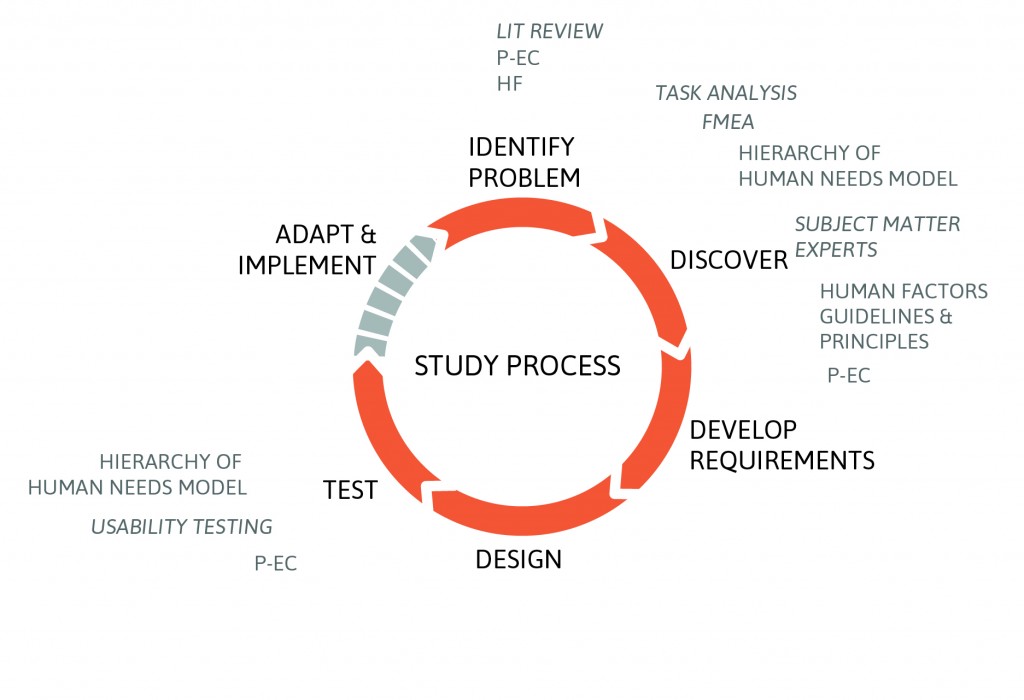Experience design and Design thinking training in South America
Thesis details
Graduate Thesis Project 2010-2014
Thesis presentation slides
Committee members
Dr Carmen Steggell, Associate Professor in the School of Design and Human Environment and the Department’s Housing Program Coordinator (OSU)
Dr Ken Funk, Associate Professor of Industrial and Manufacturing Engineering at the School of Mechanical, Industrial and Manufacturing Engineering (OSU)
Andrea Marks, Coordinator of the Graphic Design program at the School of Design and Human Environment (OSU)
Client
Bauer Labs
Abstract
I have designed a unified medical instrument for the use of doctors during the medical exam along with the iPad application that interacts with the patient electronic medical records (EMR). The device combines the functionality of a stethoscope (to listen to hear and lung sounds), otoscope (to see the ears), ophthalmoscope (to see the eyes) and dermoscope (to evaluate the skin) with a digital camera. It takes videos and pictures of ears, eyes and skin, records heart and lung sounds and automatically save that data at the patient’s medical records. The iPad application allows the user to visualize, compare patient data with reference databases and share it with doctors around the globe to seek for second opinions when facing challenging situations. Prototypes of device and application were created in terms of static mocks ups and non-functional models. Seven medical practitioners evaluated them trough role-playing scenarios. User testing results suggest that the device and application would not interfere with clinician workflow or their relationship with their patients. On the contrary the system was perceived as a communication facilitator between doctors and patients and among doctors. Some features, such as diagnostic aid, were most beneficial for beginners than for experienced practitioners. The design was found to be very useful and easy to learn and use.
Motivation
Although EMR present promising benefits such as facilitate diagnosis and prevent medical errors, doctors are not enjoying the benefits that current technologies provide because many EMR are disruptive. They are complex to use and learn and they interfere with their routine or relationship with patients. Clinicians usually lack of time to learn new systems or time to spend interacting with technology when seeing a patient – On average they have only 8 minutes per patient. Clinicians need efficient systems that are easy to use and learn. Furthermore, they need technologies that promote their communication and relationship with patients.
Purpose
To provide the benefits current technologies can provide to improve the physical exam process, analysis and documentation, without interfering with doctor-patient communication or workflow.
Thesis Process
- Literature Review
- IDEF0 (Icam DEFinition for Function Modeling) analysis of physical exam
- Task analysis
- Interviews to subject matter experts
- Failure mode and effect analysis (FMEA)
- Requirements developments (to suit clinicians’ functional, usability and emotional needs)
- Concept exploration and ideation
- Concept refinement (3 iterations)
- Prototypes for iPadd application: Wireframes
- Prototypes for all-in-one device: 3D mock ups handmade and 3D printed
- User Testing of Prototype (Role Playing Scenarios // Survey // Interviews)
- Qualitative and quantitative analysis
- Thesis Documentation
Students that collaborated during different stages of the thesis process
- Dedrie Beardsley
- Ravindrahadh Tagore Eluri
- Hui Guo
- Zhenqiang Su
- Tylee Cairns
- Lea Cavestanay
- Konstantin Brainich
- Patti Thrall
Activities related to my thesis
- Presented a Poster at the 4th international Conference on Applied Human Factors and Ergonomics. San Francisco,CA. July 2012
- Patent pending (along with Bauer labs)
- Presented a poster at the Oregon State Research expo. Portland, OR. March 2014
